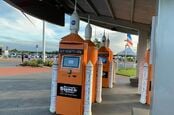This article is more than 1 year old
Fly me to the M(O2)n: Euro scientists extract oxygen from 'lunar dust' by cooking it with molten salt electrolysis
'Being able to acquire oxygen would obviously be hugely useful for future settlers'
Scientists at the European Space Agency are trying to extract oxygen from something very close to lunar soil.
The ESA team can't try their technique on actual lunar soil samples: the amounts brought back are tiny and too valuable.
Instead, the boffins have constructed a chemical equivalent, and are investigating, at a new facility at the Materials and Electrical Components Laboratory in the Netherlands, whether Moon dust could be a source of oxygen for lunar inhabitants.
Lunar regolith is the layer of soil and loose pebbles covering the Moon’s solid rocky surface. Scrapings of the stuff have revealed that it contains about 40 to 45 per cent oxygen by weight, making it the most abundant element in the lunar regolith.
The oxygen is locked up in chemical compounds with other elements in the form of minerals or glass. In order to extract it, scientists must sprinkle some Moon dust onto calcium chloride salt and cook the mixture in a metallic cauldron to 950°C (1742°F). At these temperatures, the salt melts, splitting the compound into a soup of positive calcium ions and negative chlorine ions.
Next, electrodes are placed within the chemical concoction and an electric current is passed through. The oxygen in the regolith is released and travels through the molten salt mixture to be collected at the anode – the positively charged electrode – as gas. The various metals in the lunar soil are extracted, too, from the cathode. The whole process is known as molten salt electrolysis.
“Being able to acquire oxygen from resources found on the Moon would obviously be hugely useful for future lunar settlers, both for breathing and in the local production of rocket fuel,” said Beth Lomax, a PhD student at the University of Glasgow who is working at the ESA lab.
“The production process leaves behind a tangle of different metals,” Meurisse Alexandre, a research fellow at the ESA, added. “And this is another useful line of research, to see what are the most useful alloys that could be produced from them, and what kind of applications could they be put to.”
Eventually, the research would lead to an oxygen plant capable of extracting the gas from Moon rocks on a larger scale. The ESA hope to demonstrate the feasibility of such technology in the mid 2020s –just in time if astronauts are returning to the Moon planned in 2024.
“ESA and NASA are heading back to the Moon with crewed missions, this time with a view towards staying,” said Tommaso Ghidini, head of ESA’s Structures, Mechanisms and Materials Division.
“Accordingly we’re shifting our engineering approach to a systematic use of lunar resources in-situ. We are working with our colleagues in the Human and Robotics Exploration Directorate, European industry and academia to provide top class scientific approaches and key enabling technologies like this one, towards a sustained human presence on the Moon and maybe one day Mars.” ®

